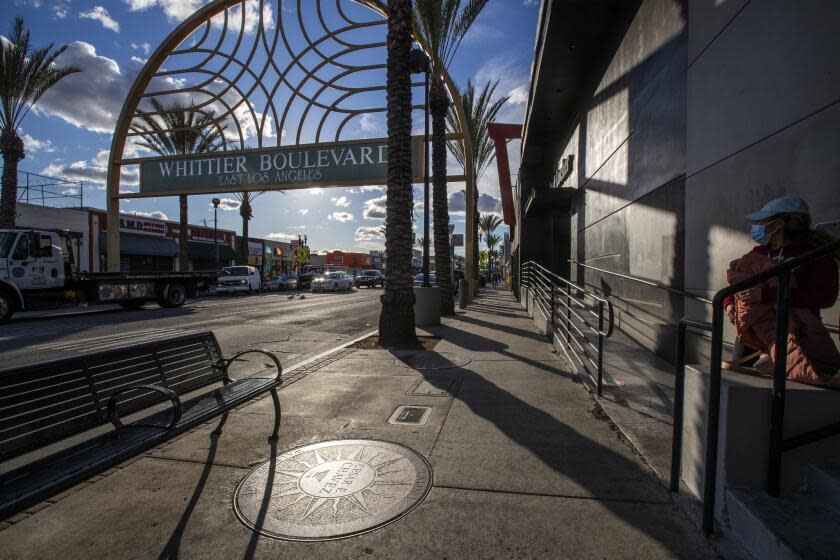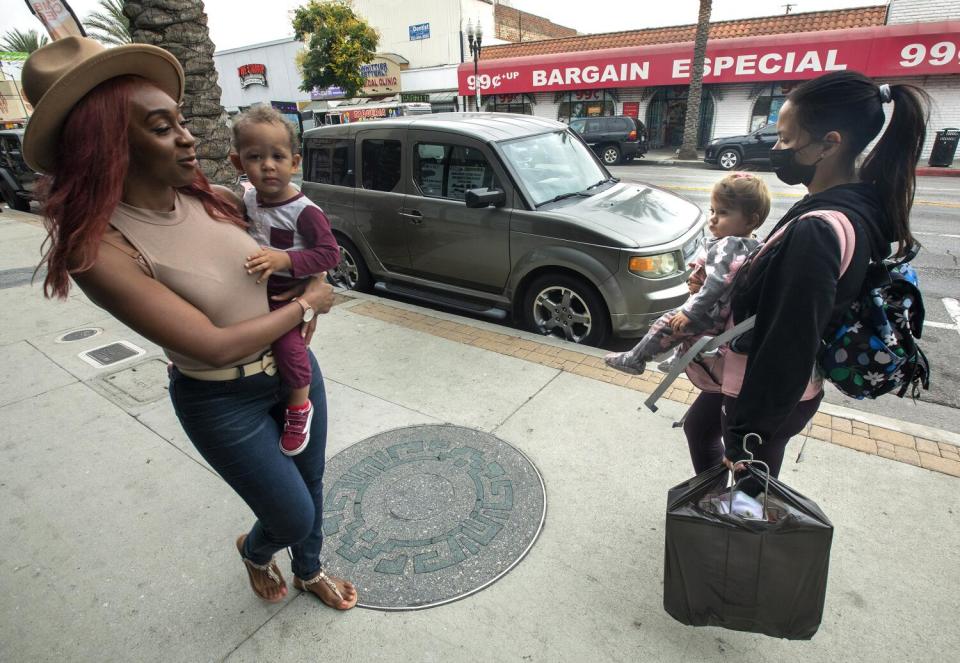Column: The dream of East L.A. as its own city rises again — along with doubters

- Oops!Something went wrong.Please try again later.
1931. 1933. 1961.
1963. 1975. 2012.
Those years were on the lips of the 130-plus people who crammed into the cavernous East Los Tacos on Friday morning to hear from Eastside Assemblymember Wendy Carrillo. She was there to address the crowd about the dream that never dies: making East L.A. its own city.
Famous across the world as a cradle of Chicano politics and culture, East L.A. is also the most populous unincorporated community in California, with about 119,000 people under the governance of L.A. County instead of their own city officials. This has rankled some residents for decades, who have pushed state and county officials to help them create a standalone municipality.
Others have fought to keep the status quo. Voters rejected incorporation in 1933, 1961 and 1975, and campaigns in 1931 and 1963 went nowhere. The late L.A. County Supervisor Gloria Molina was always skeptical of the idea, arguing it didn’t make financial sense. In 2012, the Local Agency Formation Commission — known as LAFCO — rejected a petition for cityhood signed by over 16,000 people, citing a study that said the proposed city would run a budget deficit within three years because of a lack of revenue. Services such as libraries, law enforcement and parks — which would be funded by the new city — would suffer unless residents immediately paid more taxes, the report said, also warning of an "adverse fiscal impact" on the county.
Carrillo is now sponsoring legislation, Assembly Bill 2986, asking LAFCO to create a task force to once again study the issue, this time also examining whether East L.A. can at least become a special district. That would allow residents to vote for an advisory board that could help County Supervisor Hilda Solis, whose district includes East L.A., better administer the community.
Read more: Op-Ed: Here's why East Los Angeles' bid for independence could succeed this time
The proposal has sparked buzz among incorporation hopefuls — and furious pushback from Solis.
The supervisor wasn't at the East Los Tacos gathering, but she was on the minds of everyone there. Earlier in the week, Solis had led the Board of Supervisors in unanimously opposing AB 2986 — which is still in committee — while firing off three press releases claiming “special interests” were behind the bill. She also sent out a bizarre graphic of Whittier Boulevard and its iconic arch colored a hellish red, with the slogan “Help Preserve East LA/No on AB 2986” below it. Posters of the image hung on fences near East Los Tacos.
Solis — who kindly closed a Board of Supervisors meeting last year in honor of my late grandmother, a constituent of hers — didn’t hold back when I asked over the phone who the “special interests” were.
“It's these merchants that are against street vending, cruising,” she responded. “People who are against marijuana dispensaries that are legally regulated, and against affordable housing. Affordable housing, for God's sake. It's a group of people who are saying, 'You're not helping us,' and I'm like, ‘Really?’ I go back a lot to D.C.”
The former member of Congress and U.S. secretary of Labor claimed that residents have been the beneficiary of hundreds of millions of dollars in infrastructure and services since she was first elected as supervisor in 2014. She cited the LAFCO study as proof that East L.A. wouldn’t be able to make it financially and complained that Carrillo — whom she would only refer to as “the assembly member” or “the author” — didn’t tell her about the bill.
Solis said she had a right to know about it, since “I'm technically the mayor for the area."
She also made the weird argument that East L.A. simply isn’t solid enough for cityhood.
“Ten years ago, [the population] was 129,000. Now it's less that 119,000. That isn't just endemic of East L.A., but it shows you it's transitory, and [residents] do better and move to Montebello or El Monte. East L.A. is the start, but you move on. That's our Mexican American passion, to be able to get stable.”
Perhaps realizing she was coming off as a hater, Solis added, “It doesn't mean East L.A. is bad. I don't mean that at all.”
She quickly shot me down when I mentioned that it seems the East L.A. incorporation dream never dies.
“I don't know that it never dies. “I think it comes up, then it dies.”
Damn.

I don't doubt Solis' commitment to East L.A. — but it's just one part of her district of nearly 2 million people, and she's just one supervisor out of five. It's hard enough for any small unincorporated community to get attention. When you're as huge as East L.A., it's probably best to have more than one local elected official looking out for you. For that official to say a study looking into expanding representation isn't worth it because she knows better comes off like she's clinging to power.
Solis should’ve been there at East Los Tacos, where the crowd was overwhelmingly in favor of incorporation. They were senior citizens and youngsters, college professors and business owners, political operatives and regular folks I’ve known for years. They grabbed pan dulce and coffee, fact sheets and a form letter arguing in favor of Carrillo’s proposed legislation, and vented about what they claimed was decades of political neglect.
“I'm upset. I'm disappointed,” said Laura Barrera, a 49-year-old East L.A. lifer. “It's a disrespect to this community. I see Atlantic [Boulevard] — it's not revitalized. I see Whittier [Boulevard] — it hasn't gotten support. We're never going to be viable as a community financially unless we have a conversation” about incorporation.
If that happened, East Los Angeles would be the 10th-largest city in L.A. County and would tie Laredo, Texas, as the most Latino city in the U.S. with a population of over 100,000 people, at 95.5%. It’s that real-life and symbolic power that has motivated activists to repeatedly push for incorporation, said retired Cal State Los Angeles political science professor Jaime Regalado. The problem, however, is that proponents have never translated that passion into a movement that holds for long.
Read more: A city grows in East L.A.?
“It's always been, ‘Well, good luck. Make sure you have the right ducks lined up, and then it will be tough,’” Regalado said. “The 'no' side has done a much better job of selling fear of the unknown. Fear of who your neighbor might be.
“I'm not trying to sell the 'yes' side short,” he added. “I'm in favor of it, but it's had a dismal record. Oh for six is oh for six."
Eddie Torres, former president of the East Los Angeles Chamber of Commerce, opened the East Los Tacos forum by leading the Pledge of Allegiance. He previously opposed incorporation but offered his full support of Carrillo's bill.
“I'm already 66 years old and on my way out,” said the commercial printer. “But this is for the future.”
Carrillo, who recently placed fourth in the race to challenge Eastside City Councilmember Kevin de León, started by downplaying chisme that she only cares about East L.A. incorporation because it would create new elected offices to pursue.
“I’m not trying to be the mayor of East L.A.” the assembly member said, joking that “I get booed, but it's OK!” because she graduated from Roosevelt High in Boyle Heights. As if on cue, someone shouted, “Garfield!” Roosevelt’s chief rival, to laughs and applause.
Speaking calmly in English and Spanish, Carrillo — who was a volunteer for the unsuccessful 2012 incorporation attempt — gave a short history of previous efforts. She noted how neighboring cities over the decades have chipped away at East L.A.'s tax base by swallowing up vital assets like industrial parks and East Los Angeles Community College, which is actually in Monterey Park.
“If the fiscal study at the end of the day says [incorporation or special district status is] not possible, it's not possible,” she said. “But I'm in a place where I no longer want to hear what's not feasible. I want to hear what's possible.”
Other speakers followed Carrillo before Torres introduced some Solis staffers. First up was Waqas Rehman, her director of planning and development. While admitting that there are “tons of historic injustices that have led East L.A. to not have a tax base,” he said the real culprit is how Sacramento distributes vehicle license fees, which has effectively shut out newly formed cities from those funds since 2011. Incorporation wouldn’t remedy anything, Rehman said.
Solis, he added, “does want the right solution. What she's worried about is setting up a study that leads to a solution that shortchanges the residents."
Torres suddenly interrupted. “He's still talking about cityhood. We're not. He's confusing the issue. Sorry, bro."
Tami Omoto-Frias, Solis’ senior budget deputy, soon jumped in.
“Whether it's a city, whether it's a special district,” she said, “it has to support itself.”
“Well, let's find out!” someone screamed.
The meeting ended, and Torres urged those who remained to gather for a group photo. Only 25 people took part, but they were excited and chanted, "East L.A.! East L.A.!" while holding signs that were the cheery inverse of Solis' apocalyptic Whittier Boulevard arch graphic — white and blue, with the slogan "East LA Community Supports AB 2986/Our Voices Deserve to Be Heard."
Sitting by himself reviewing notes was Jeff Nava, a Cal Poly Pomona student who attended the meeting for a political science project on local government. He was surprised to learn that East L.A. wasn't already a city because “it's such a large place and so historic.”
I asked the 20-year-old if he was in favor of incorporation, based on what he heard. He said he wants to study the issue more.
“Every community should have representation,” he said. “What I did like to see was that people care about the situation.”
This story originally appeared in Los Angeles Times.

